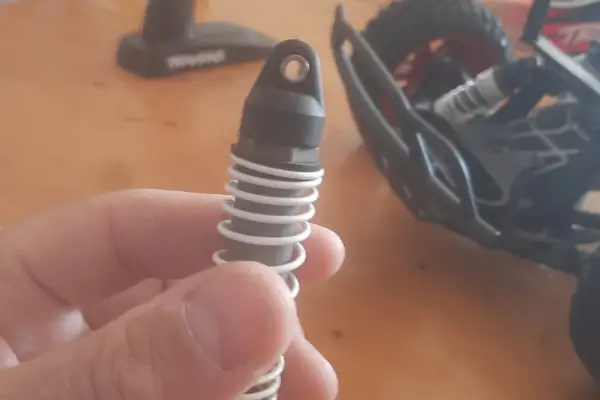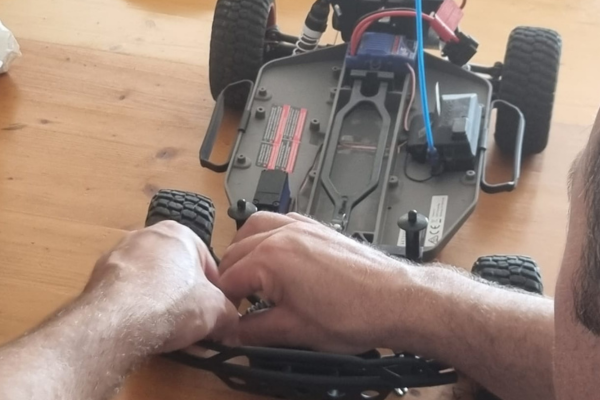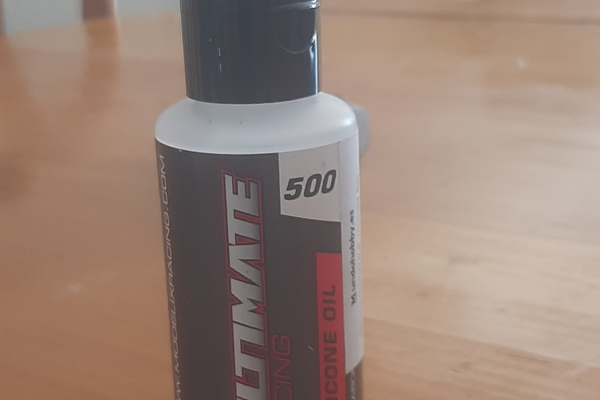The oil inside a shock absorber is a key component for the shock to work properly. If the shocks become empty without you realizing it, you will damage the rest of your car. So replacing the oil in the shocks is important for maintaining your car.
In short, you can change RC shock oil by first removing the shocks from the car. Then gently unscrew the shock cap with pliers and empty the old oil. Clean the shock vat out if required and fill it up with the new oil. Finally, screw the cap back on and reinstall the shocks before a test drive.
Before you pull that acceleration trigger, just drop the car from around 1 or 2 feet in the air to see how the shocks react. You can also push down on the car to see if the shocks are slowing the movement down.
If you find that the vehicle still isn’t handling properly, work your way through this guide to make sure you’re replacing the oil correctly.
Steps For Changing Your RC Shock Oil
Here are more detailed instructions on how to replace the oil in your RC car’s shocks:
Remove the shocks from your RC car

Before you start working on the RC car shocks, remove them from the car. I find that doing this makes it easier to access and work on them.
There are thousands of RC models and many different ways to remove the shocks, so follow your RC car’s manual or instructions to do the job properly. If you don’t have a manual, you can also search for online tutorials or videos that show you how to remove and reinstall shocks for your specific RC car model.
Use a pair of pliers to unscrew the top of the shock absorber

To gain access to the inside of the shock absorber, you’ll need to unscrew the top of the shock. You can use a pair of pliers to do this, just be careful not to squeeze too hard or you’ll break the cap. You may also want to use a towel or rag to protect the shock body from scratches or damage.
Pour out the old oil from the shock absorber
Once you’ve removed the shock cap, pour out the old oil from the shock if there is any. Be sure to pour the oil into a container or paper towel to avoid spills or mess. Use a funnel or syringe to further avoid spills or waste. Clean the shock body with a rag or paper towel to remove any dirt or debris.
Fill the shock absorber with new shock oil

Once you’ve removed the old oil, you can fill the shock absorber with new oil. Be sure to use the right weight/viscosity for your driving needs and follow the manufacturer’s recommendations. You can also refer to my RC shock oils guide to find out which oil to use.
Use a syringe or dropper to fill the shock absorber with the new oil. Perform the task slowly to help avoid air bubbles and ensure that the shock is filled properly.
Trust me, don’t just tip it in, the shock fills so fast, you will definitely spill some!
Reattach the top of the shock absorber using the pliers.
Once you’ve filled the shock absorber with oil, reattach the shock cap using your pliers.
Make sure the cap is screwed on tightly to avoid leaks. If you have a massive RC car, you may want to use a torque wrench to ensure that the cap is tightened to the proper torque specifications.
Repeat steps 2-5 for each of the other shocks on your RC car
Keep track of which shock you have already worked on to avoid missing any. You may also want to label each shock with a marker or piece of tape to help you remember which one you have already serviced.
Reinstall the shocks onto your RC car

Once you have replaced the oil in all of your shocks, you can reinstall them onto your RC car.
Make sure to follow the manufacturer’s instructions or manual to reinstall the shocks properly. You should also test drive your RC car to ensure the shocks are working properly and the new oil is performing as expected.
How Much Oil Does It Take To Fill RC Shocks?
Most RC car shocks require around 1-2ml of shock oil per shock absorber.
However, this can vary significantly depending on the size and type of the shock, so it’s important to refer to the manufacturer’s specifications in your owner’s manual to ensure that you’re filling the shocks correctly.
What Kind Of Oil Do You Put In RC Car Shocks?
Silicone oil is the most common oil used in RC car shocks and is available in a range of viscosities or weights.
Besides silicone oil, other types of oils that are used for RC car shocks include the following.
Mineral oil
This type of oil is less common for RC car shocks, but it can be used as an alternative to silicone oil.
Synthetic oil
Synthetic oils can be used for RC car shocks and are mixed to provide specific performance enhancements, like better durability or heat resistance.
Vegetable oil
While not commonly used, some RC car enthusiasts experiment with vegetable oil like sunflower or olive oil as an alternative to silicone oil.
Check out my guide to the best homemade RC shock oils
What Does Thicker RC Shock Oil Do For RC Cars?
Thicker RC shock oil increases the damping force in the shock. This makes it harder for the shock to compress and provides a firmer suspension for better handling. This can be useful for certain types of driving, like on high-traction surfaces or for larger, heavier RC cars.
However, it can also reduce the car’s ability to handle bumps and jumps because the thick oil reacts too slowly, so determine the right viscosity for your specific RC car and the terrain you plan to drive on.
See my RC suspension system types and parts 101 guide if you want to learn more about all the associated technical parts.
And speaking of RC suspension, I also highly suggest checking out this detailed guide where I talk about RC suspension tuning and different ways to adjust the suspension system.
Does RC Shock Oil Go Bad?
RC shock oil can go bad. Shock oil degrades or breaks down due to exposure to heat, moisture, and air. When the oil breaks down, it loses its viscosity and becomes less effective at absorbing the impacts of the shocks. This leads to poor performance and handling of the car.
I recommend you replace the shock oil periodically, especially if you notice any changes in the handling or performance. Generally, it’s good to replace the shock oil every 6-12 months, depending on how frequently you use your RC car and the conditions it’s operated in. This is if you use the car once a week. If you use the car multiple times per week in rough off-road terrains, you might need to replace the shock oil sooner. Additionally, if you notice any unusual odors in the shock oil, it may be a sign that it has gone bad and needs to be replaced.
How Do You Know If Oil Shocks Are Bad?
Several signs indicate that the shocks on an RC car may have gone bad:
Leaking oil
If you notice oil leaking from the shocks, it is a sign that the seals have worn out or are damaged, and the oil is no longer contained within the shock.
Reduced performance
If you find that the car is bouncing more than usual or not handling corners as well as it used to, it could be due to the shock oil losing its viscosity and not providing enough damping.
Squeaking or creaking noises
If you hear squeaking or creaking noises when the shocks compress and rebound, it could indicate that the oil has lost its lubricating properties.
Damaged shock bodies
If the shock bodies themselves are damaged, such as being bent or dented, it can also affect their performance and cause problems.
If you notice any of these signs, I recommend you replace the shock oil and seals or the entire shock assembly if necessary to restore the performance of your RC car.
Which Oil Is Best For RC Shock Absorbers?

Silicone oil manufactured specifically for RC shocks is the best oil to use. Thicker oils such as 50-weight or 60-weight are commonly used for off-road bashing, while lighter oils such as 20-weight or 30-weight are better suited for on-road racing. But I recommend you experiment with different weights and brands of oil to find the one that works best for your specific RC car and driving style.
Please check out my in-depth guide explaining RC shock oil weight. It covers everything you need to know from the type of RC car to weather conditions, type of track and more.
The best oil for RC shock absorbers depends on various factors such as the type of terrain you’re driving on, the weight of your vehicle, and your personal preferences.
Check out this post: RC Car Suspension Types And Parts 101: A Complete Guide
In Summary
It’s important to replace RC shock oil periodically to maintain its performance. Keep in mind that shock oil goes bad. If you notice changes in the car’s handling or performance, you need to replace the shock oil.
This involves removing the shocks from the car, unscrewing the shock cap, emptying the old oil, cleaning the shock body, filling it with new oil, and reattaching the shock cap. You should use the right weight/viscosity of oil depending on your driving needs and the manufacturer’s recommendations. So take the advice from this guide and keep your RC shock oil fresh.

